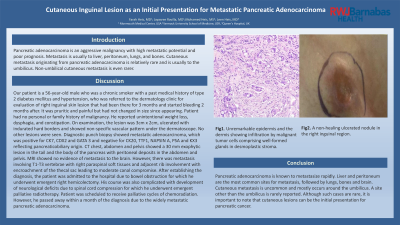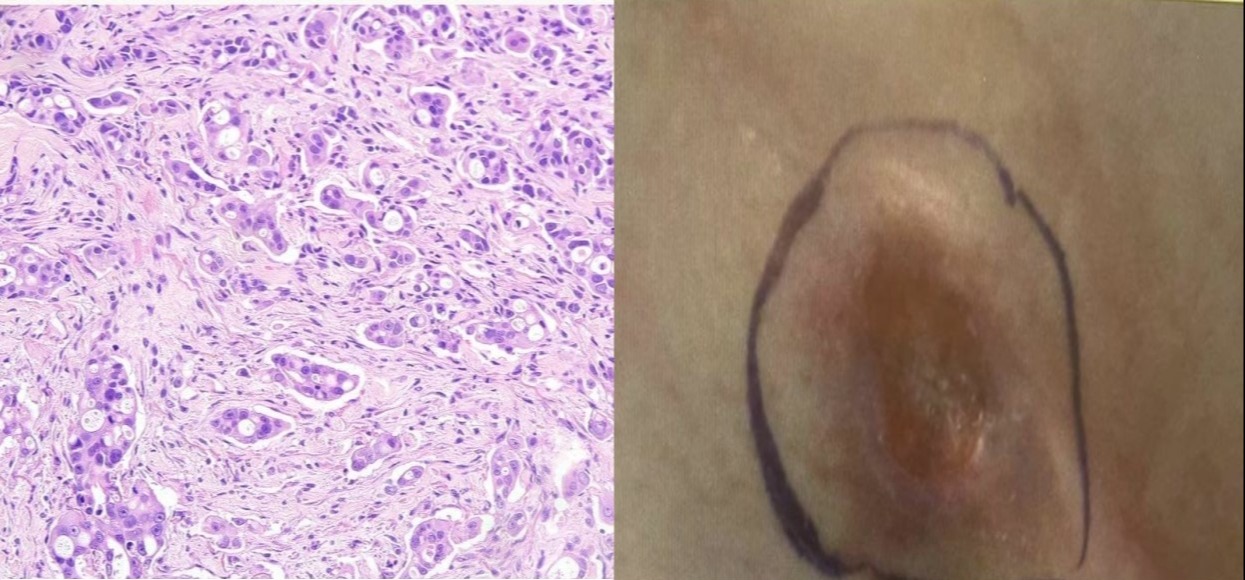Sunday Poster Session
Category: Biliary/Pancreas
P0096 - Cutaneous Inguinal Lesion as an Initial Presentation for Metastatic Pancreatic Adenocarcinoma
Sunday, October 22, 2023
3:30 PM - 7:00 PM PT
Location: Exhibit Hall

.jpg)
Farah Heis, MD
Rutgers Health/Monmouth Medical Center
Columbia, MO
Presenting Author(s)
Award: Presidential Poster Award
Farah Heis, MD1, Jayasree Ravilla, MD2, Mohamed Heis, MS3, Leen Heis, MD4
1Rutgers Health/Monmouth Medical Center, Long Branch, NJ; 2Monmouth Medical Center/RWJBH, Long Branch, NJ; 3Yarmouk University School of Medicine, Irbid, Irbid, Jordan; 4Queen's Hospital, Romford, England, United Kingdom
Introduction: Pancreatic adenocarcinoma is an aggressive malignancy with high metastatic potential and poor prognosis. Metastasis is usually to liver, peritoneum, lungs, and bones. Cutaneous metastasis originating from pancreatic adenocarcinoma is relatively rare and is usually to the umbilicus. Non-umbilical cutaneous metastasis is even rarer.
Case Description/Methods: Our patient is a 56-year-old male who was a chronic smoker with a past medical history of type 2 diabetes mellitus and hypertension, who was referred to the dermatology clinic for evaluation of right inguinal skin lesion that had been there for 3 months and started bleeding 2 months after. It was pruritic and painful but had not changed in size since appearing. Patient had no personal or family history of malignancy. He reported unintentional weight loss, dysphagia, and constipation. On examination, the lesion was 3cm x 2cm, ulcerated with indurated hard borders and showed non-specific vascular pattern under the dermatoscope. No other lesions were seen. Diagnostic punch biopsy showed metastatic adenocarcinoma, which was positive for CK7, CDX2 and GATA 3 and negative for CK20, TTF1, NAPSIN A, PSA and KX3 reflecting pancreaticobiliary origin. CT chest, abdomen and pelvis showed a 30 mm exophytic lesion in the tail and the body of the pancreas with peritoneal deposits in the abdomen and pelvis. MRI showed no evidence of metastasis to the brain. However, there was metastasis involving T1-T3 vertebrae with right paraspinal soft tissues and adjacent rib involvement with encroachment of the thecal sac leading to moderate canal compromise. After establishing the diagnosis, the patient was admitted to the hospital due to bowel obstruction for which he underwent emergent right hemicolectomy. His course was also complicated with development of neurological deficits due to spinal cord compression for which he underwent emergent palliative radiotherapy. Patient was scheduled to receive palliative cycles of chemoradiation. However, he passed away within a month of the diagnosis due to the widely metastatic pancreatic adenocarcinoma.
Discussion: Pancreatic adenocarcinoma is known to metastasize rapidly. Liver and peritoneum are the most common sites for metastasis, followed by lungs, bones and brain. Cutaneous metastasis is uncommon and mostly occurs around the umbilicus. A site other than the umbilicus is rarely reported. Although such cases are rare, it is important to note that cutaneous lesions can be the initial presentation for pancreatic cancer.

Disclosures:
Farah Heis, MD1, Jayasree Ravilla, MD2, Mohamed Heis, MS3, Leen Heis, MD4. P0096 - Cutaneous Inguinal Lesion as an Initial Presentation for Metastatic Pancreatic Adenocarcinoma, ACG 2023 Annual Scientific Meeting Abstracts. Vancouver, BC, Canada: American College of Gastroenterology.
Farah Heis, MD1, Jayasree Ravilla, MD2, Mohamed Heis, MS3, Leen Heis, MD4
1Rutgers Health/Monmouth Medical Center, Long Branch, NJ; 2Monmouth Medical Center/RWJBH, Long Branch, NJ; 3Yarmouk University School of Medicine, Irbid, Irbid, Jordan; 4Queen's Hospital, Romford, England, United Kingdom
Introduction: Pancreatic adenocarcinoma is an aggressive malignancy with high metastatic potential and poor prognosis. Metastasis is usually to liver, peritoneum, lungs, and bones. Cutaneous metastasis originating from pancreatic adenocarcinoma is relatively rare and is usually to the umbilicus. Non-umbilical cutaneous metastasis is even rarer.
Case Description/Methods: Our patient is a 56-year-old male who was a chronic smoker with a past medical history of type 2 diabetes mellitus and hypertension, who was referred to the dermatology clinic for evaluation of right inguinal skin lesion that had been there for 3 months and started bleeding 2 months after. It was pruritic and painful but had not changed in size since appearing. Patient had no personal or family history of malignancy. He reported unintentional weight loss, dysphagia, and constipation. On examination, the lesion was 3cm x 2cm, ulcerated with indurated hard borders and showed non-specific vascular pattern under the dermatoscope. No other lesions were seen. Diagnostic punch biopsy showed metastatic adenocarcinoma, which was positive for CK7, CDX2 and GATA 3 and negative for CK20, TTF1, NAPSIN A, PSA and KX3 reflecting pancreaticobiliary origin. CT chest, abdomen and pelvis showed a 30 mm exophytic lesion in the tail and the body of the pancreas with peritoneal deposits in the abdomen and pelvis. MRI showed no evidence of metastasis to the brain. However, there was metastasis involving T1-T3 vertebrae with right paraspinal soft tissues and adjacent rib involvement with encroachment of the thecal sac leading to moderate canal compromise. After establishing the diagnosis, the patient was admitted to the hospital due to bowel obstruction for which he underwent emergent right hemicolectomy. His course was also complicated with development of neurological deficits due to spinal cord compression for which he underwent emergent palliative radiotherapy. Patient was scheduled to receive palliative cycles of chemoradiation. However, he passed away within a month of the diagnosis due to the widely metastatic pancreatic adenocarcinoma.
Discussion: Pancreatic adenocarcinoma is known to metastasize rapidly. Liver and peritoneum are the most common sites for metastasis, followed by lungs, bones and brain. Cutaneous metastasis is uncommon and mostly occurs around the umbilicus. A site other than the umbilicus is rarely reported. Although such cases are rare, it is important to note that cutaneous lesions can be the initial presentation for pancreatic cancer.

Figure: Fig1. Unremarkable epidermis and the dermis showing infiltration by malignant tumor cells comprising well-formed glands in desmoplastic stroma.
Fig2. A non-healing ulcerated nodule in the right inguinal region.
Fig2. A non-healing ulcerated nodule in the right inguinal region.
Disclosures:
Farah Heis indicated no relevant financial relationships.
Jayasree Ravilla indicated no relevant financial relationships.
Mohamed Heis indicated no relevant financial relationships.
Leen Heis indicated no relevant financial relationships.
Farah Heis, MD1, Jayasree Ravilla, MD2, Mohamed Heis, MS3, Leen Heis, MD4. P0096 - Cutaneous Inguinal Lesion as an Initial Presentation for Metastatic Pancreatic Adenocarcinoma, ACG 2023 Annual Scientific Meeting Abstracts. Vancouver, BC, Canada: American College of Gastroenterology.

